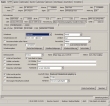If you read Jeremy Zawodny’s blog post, Yahoo! is currently searching for XUL developers (rumours said they want to deliver their PhotoMail application on a XUL based UI). There are some fancy and fantastic XUL applications out there, for example Bloxor or the Mozilla Amazon Browser.
 XUL stands in a row to Microsoft’s upcoming XAML or Macromedia’s Flexx. The advantage of XUL is pretty clear: it’s an OpenSource technology brought to you by Mozilla. I hope the XULRunner project will go on very fast so that you don’t have to deliver the whole Mozilla/Firefox browser. My company makes some pretty big XUL application (it seems to be the largest XUL project throughout Europe) for the car rental company Sixt. While those applications are mainly for internal use (i.e. for the call centers or the POS), we prove that XUL makes your legacy applications fit for the Web. It’s a client-server model with XUL/JS on the client side and PHP with a Cobol extension that we’ve written on the backend. We don’t have to deal with complicated DHTML stuff, with XUL you only have to describe the widgets you want to have. Since the applications are mainly for the POS or call center staff the main focus on the application design is a fast usage – i.e. fully keyboard accessible, no fancy graphic stuff etc. In these projects we don’t focus on the „Joy of Use“.
XUL stands in a row to Microsoft’s upcoming XAML or Macromedia’s Flexx. The advantage of XUL is pretty clear: it’s an OpenSource technology brought to you by Mozilla. I hope the XULRunner project will go on very fast so that you don’t have to deliver the whole Mozilla/Firefox browser. My company makes some pretty big XUL application (it seems to be the largest XUL project throughout Europe) for the car rental company Sixt. While those applications are mainly for internal use (i.e. for the call centers or the POS), we prove that XUL makes your legacy applications fit for the Web. It’s a client-server model with XUL/JS on the client side and PHP with a Cobol extension that we’ve written on the backend. We don’t have to deal with complicated DHTML stuff, with XUL you only have to describe the widgets you want to have. Since the applications are mainly for the POS or call center staff the main focus on the application design is a fast usage – i.e. fully keyboard accessible, no fancy graphic stuff etc. In these projects we don’t focus on the „Joy of Use“.
The Mozilla developers are pointing out the „Joy of XUL“, but where’s the „Joy of Use“? Applications like Bloxor or MAB demonstrate the Joy of Use, but they don’t seem to be the majority. Let’s change that together!
You can download the English speaking ![]() XUL Case Study for the Sixt projects (German version available
XUL Case Study for the Sixt projects (German version available ![]() here). If you are already using XUL in your company, check out the next issue of the German speaking PHP Magazin: there’s a CaseStudy about the XUL based intranet of Springer&Jacoby, a German multimedia agency.
here). If you are already using XUL in your company, check out the next issue of the German speaking PHP Magazin: there’s a CaseStudy about the XUL based intranet of Springer&Jacoby, a German multimedia agency.
I would be happy if you could tell me your thoughts about XUL via e-mail or in the blog comments. Where are you already using XUL? Have you looked at it and considered it for your applications? Does XUL open new ways of rapid application development, applications where HTTP connectivity is available out of the box? If you need help or advise from our XUL expert team where XUL could help your IT, please let me know.


Schreibe einen Kommentar